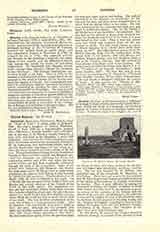

Clitherow, MARGARET, VENERABLE, Martyr, called the “Pearl of York”, b. about 1556; d. March 25, 1586. She was a daughter of Thomas Middleton, Sheriff of York (1564-5), a wax-chandler; married John Clitherow, a wealthy butcher and a chamberlain of the city, in St. Martin‘s church, Coney St., July 8, 1571, and lived in the Shambles, a street still unaltered. Converted to the Faith about three years later, she became most fervent, continually risking her life by harboring and maintaining priests, was frequently imprisoned, sometimes for two years at a time, yet never daunted, and was a model of all virtues. Though her husband belonged to the Established Church, he had a brother a priest, and Margaret provided two chambers, one adjoining her house and a second in another part of the city, where she kept priests hidden and had Mass continually celebrated through the thick of the persecution. Some of her priests were martyred, and Margaret who desired the same grace above all things, used to make secret pilgrimages by night to York Tyburn to pray beneath the gibbet for this intention. Finally arrested on March 10, 1586, she was committed to the castle. On March 14, she was arraigned before Judges Clinch and Rhodes and several members of the Council of the North at the York assizes. Her indictment was that she had harbored priests, heard Mass, and the like; but she refused to plead, since the only witnesses against her would be her own little children and servants, whom she could not bear to involve in the guilt of her death. She was therefore condemned to the peine forte et dure, i. e. to be pressed to death. “God be thanked, I am not worthy of so good a death as this”, she said. Although she was probably with child, this horrible sentence was carried out on Lady Day, 1586 (Good Friday according to New Style). She had endured an agony of fear the previous night, but was now calm, joyous, and smiling. She walked barefoot to the tollbooth on Ousebridge, for she had sent her hose and shoes to her daughter Anne, in token that she should follow in her steps. She had been tormented by the ministers and even now was urged to confess her crimes. “No, no, Mr Sheriff, I die for the love of my Lord Jesu’, she answered. She was laid on the ground, a sharp stone beneath her back, her hands stretched out in the form of a cross. Then a door was placed upon her and weighted down till she was crushed to death. Her last words during her fifteen-minute agony were “Jesu, Jesu, Jesu, have mercy on me!” Her right hand is preserved ot St Mary’s Convent, York, but the resint-place of her sacred body is not known. Her sons Henry and William became priests, and her daughter Anne a nun at St Ursula’s, Louvain.
BEDE CAMM

